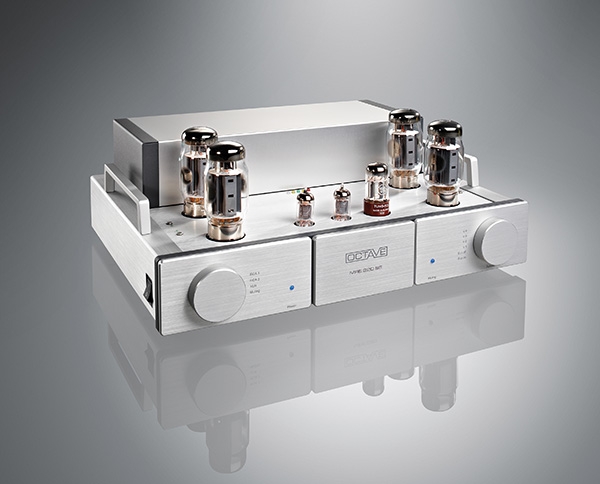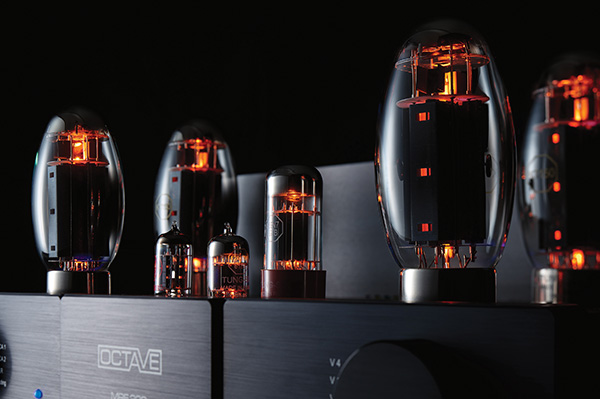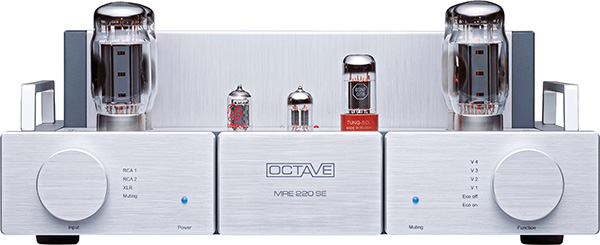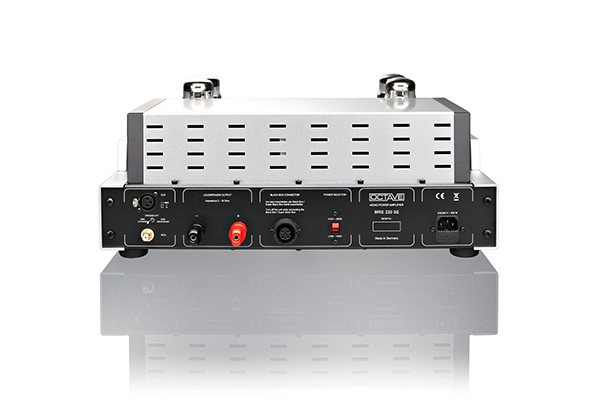| Columns Retired Columns & Blogs |
I always have to laugh when someone has a (way too) expensive stereo set and then streams music, that's like a Ferrari on a bumpy dirt road, then you don't understand it

The special sound of tubes, which flows like water and sometimes shines like the golden sun you hopefully shielded your eyes from during the recent eclipse, makes it all worth it—if the design and implementation are good and you can't get similar sound from low-maintenance solid state (footnote 1).
I haven't reviewed much tube gear, but when I have—Bruce Moore and VTL (in my pre-Stereophile days), Audio Research, and in our September 2022 issue (footnote 2), the towering Octave Jubilee Mono SE tubed pentode push-pull monoblocks (footnote 3)—I've been enamored of their sound. I waxed ecstatic about the "captivating beauty" and "heavenly" highs of the Jubilee Mono SEs. I can still recall how gorgeous they sounded; every listen was special.
Hence, my enthusiastic "yes" to a solicitation from John Quick, VP of Sales & Marketing for Dynaudio North America, Octave's North American distributor, to review the smaller MRE 220 SE (footnote 4) mono push-pull tube amplifier ($28,500/pair base price, $37,100/pair in the ultimate configuration, which I received). Having discovered that the common output power specifications do not correlate perfectly with an amp's ability to control bass, I reckoned the rated output of 200W average and 220W peak power into 4 ohms would work just fine with my reference Wilson Alexia Vs.

Options, we have options
Each MRE 220 SE monoblock uses four power output tubes—KT88s, KT120s, or KT150s are recommended and available from Octave—and three driver tubes: one 6SN7GTB (a 6SN7 with a maximum plate voltage that's 50% higher) and two ECC802s (footnote 5). A few options are offered with the MRE 220 SE that can affect its sound.
Power Tubes. You can choose among KT88 (supplied with the base unit), KT120 (adds $800/set), or KT150 (adds $1600/set). During an extended Zoom interview with Quick and Octave founder/chief designer Andreas Hofmann, Hofmann said, "To my ears, KT88 sounds quite a little bit soft. Sound and quality-wise, KT150 is best. But it's also a question of the speaker and the quality of the system. If somebody has a less-demanding system than yours, the top is sharp, or the sound is darker, they may prefer KT88."
Power Supply. You can boost the capacity of the MRE 220 SE's internal power supply via an external capacitor bank called the Super Black Box (footnote 6; adds $7000/pair). The Super Black Box connects to the amp via a flexible, screw-on umbilical cord. Adding the SBB to the MRE takes only a few minutes.
The manual says the Super Black Box "significantly increases power supply capacitance to stabilize current delivery and reduce impedance interaction of the load, thus improving dynamic range, separation, depth, soundstage size and articulation. This enables optimizing the MRE 220 in respect to the speaker, Which is a tremendous benefit if the speaker is difficult to drive."
Input Choice. The choice of XLR or RCA will have sonic consequences. Which is better? Octave's Michael Nonnenmann wrote, "We do not prefer any connection method. It depends on what devices you use. Please test for yourself which connection sounds best." Because I was using a dCS Vivaldi Apex DAC as my volume control, I was able to try both options. More on this topic follows.
(In addition to RCA and XLR inputs, the Octave MRE 220 SE has optional RCA 2 input designed to reduce hum and eliminate signal ground/protective ground issues in some countries. RCA 2 is not recommended for US users and was not fitted to the measurement sample.)
Passive Filter. Octave makes a relatively compact but hefty passive filter called the Filter 3-P ($3000), designed to be inserted in the analog interconnect path between a preamp and each SE 220. (It can also be used between preamps and DACs.) The Filter 3-P is designed "to eliminate the problem of propagation of conducted electromagnetic interference," which travels in both directions on ground lines. There are different filters for users of RCA and XLR interconnects; mine was designed for XLR (footnote 7). "It's a special type of transformer with a high capability to block the high frequencies," Hofmann explained. "The so-called common-mode rejection ratio (CMMR) is quite high. The frequency range is flat up to 100kHz, but it blocks high-frequency distortions from the mains that travel in both directions on the ground, from the network, and so on. You can also use it between the DAC and the input section of the preamp to address jitter that can mask details." The Filter 3-P requires an additional set of interconnects.
Ground-Lift Switch. It's on the rear panel. When in the "connected" position, ground resistance is 0 ohms; in the "disconnected" position, it is 18 ohms. In normal use, when no ground-related hum is present, the "connected" position is appropriate. "All manufacturers, including cable manufacturers, treat grounding differently," Hofmann said. "Cable capacitance can create high-frequency distortions on the ground line, and components' internal circuitry can sometimes float above the main earth ground. Some manufacturers reverse pins on XLR, which can cause problems, and some use two-prong power cords that lack a third wire for an independent ground. Even the network may not be properly grounded."
"Issues can develop when you join together the grounds of different components," Quick added. "Ground loops can arise when monoblocks and source components are plugged into different circuits. Lifting the ground allows interconnects to ground everything to one place rather than multiple places that may have different ground potentials." Depending on the precise cause, that may get rid of any ground-loop hum.
Adjustable Damping Factor. The SE 220 has an adjustable high/low damping factor to, in the words of the website, "adapt ... to [and] ideally suit the higher demands of modern loudspeakers." The factory setting is "low."
"With low or reduced feedback, the damping factor is very low," Hofmann said. "In my opinion, a good speaker with good magnetic efficiency like your Wilsons does not require a high damping factor. As much as an amplifier controls the sound, the loudspeaker system must have its own control. Otherwise, it's a poor design. A few exotic or old speakers—an old B&W or Dynaudio, for example—need a high damping factor; the newer Dynaudios do not."
"I've designed amplifiers for 20 or 30 years, and I still feel that we need a certain amount of feedback and a bit of damping, but not too much. Otherwise, the midrange sounds flat or less than good. Adjusting feedback is a very, very sensitive thing. Too many amplifiers have too high a damping factor and too much feedback. Too much feedback kills the sound."

Layout, features, and biasing
The 220 SE arrives with a protective grille over the tubes. The product manual declares, "Operating the amplifier without its protective grille is dangerous and not recommended." Quick gave the okay to remove the grilles.
A small power-rocker switch is located on the left side of the amplifier, close to the front. The front panel holds two large selector knobs. The left knob selects input (RCA 1, RCA 2, XLR, or Mute; you can connect or change cables with the switch in the Mute position, without switching off the amplifier).
The right knob selects one of the four tubes, "V 4, V 3, V 2, or V 1," for biasing. It can also put the amp in either "Eco off " or "Eco on" mode. In "Eco on," the amp remains fully warmed up and ready for use unless no signal is present for approximately 10 minutes. After that, it enters sleep mode, draws 20W idle current, and produces very little heat. When a music signal is detected, the Eco mode circuit powers the unit back on with a 20–30 second warm-up/start-up delay. Eco mode is said to increase tube life and ensure that nothing bad or dangerous happens when you leave the amp switched on. Tube-biasing is only possible with "Eco off."
Pre-measured tubes arrive in a separate box, with amplifier positions labeled for the power tubes. If you use these, you're golden. If you want to roll tubes, manual bias adjustment is necessary. Turn the front-panel bias selector knob to the tube you wish to bias, then use the supplied small screwdriver to adjust the trimmer screw next to the tube. Yellow and green LEDs located between tubes V2 and V3 indicate if bias is too low, correct, or too high. Combinations of yellow and green allow you to tweak bias higher and lower according to tube choice and loudspeaker type. Sayeth the manual, "Certain loudspeakers may benefit from the higher bias current, as it will increase the damping factor and provide slightly better control of the speakers." BIAS Low corresponds to a plate current of 33mA, and BIAS high to a plate current of 40mA.
After biasing the tubes, you can set the right knob to "Eco off " and start listening right away. Alternately, you can remain in "Eco on" and, after a short pause when the start-delay circuit kicks in, signal will begin traveling to your speakers. In either scenario, sound will continually improve over the first 12–15 minutes, until the amps are fully warmed up.

The rear panel contains XLR (pin 2 is positive) and RCA inputs; that ground-lift toggle switch; loudspeaker outputs that accept either spade or 4mm banana connectors; and a place to connect an umbilical cord to the Super Black Box. There's also a "HIGH – 200W/LOW – 140W" power selector. KT120 and KT150 tubes require the high setting while regular KT88s require low; Octave's preferred KT88 S4A Carbon can use either setting. Rounding things out are the serial number and an IEC socket with an integrated fuse holder.
Additional design details
In contrast to most tube amps, it's okay to operate the MRE 220 with no loudspeaker connected because "The MRE 220, like all Octave amplifiers, is fully protected against open circuit operation, ie, the amplifier will come to no harm if it is operated without loudspeakers connected and the input level is in the magnitude of normal listening levels." The amp's soft-start technology is said to greatly extend tube life; tubes "normally sound the same throughout their service life." When an output tube has reached the end of its useful life, you won't be able to adjust the bias correctly.
Octave's website (footnote 8) declares that the MRE 220 SE mono power amplifiers have been "completely redesigned" relative to the non-SE versions, with a new power supply and output transformer section design. The company says the amplifier is stable down to a loudspeaker impedance of 2.5 ohms and that its S/N ratio is >116dB (no ref. level specified). The manual touts the amplifier's double-sided PCB with plated-through holes using 70µm copper, ceramic tube bases with silver contacts, specially selected and burned-in long-life tubes, and professional low-inductance electrolytic capacitors.
I asked Hofmann if he had different design goals for his larger and more costly Jubilee floorstanding monoblocks. "The MRE 220 SE is, in my opinion, the best compromise we can produce in terms of dimensions, price, and power," he answered. "The sonic goals are the same, but with the Ultimate, I want to expand an amplifier's possibilities as much as possible in terms of dynamics, power bandwidth, and so on. That requires a big amplifier with eight tubes, more power from an oversized power supply, and most important, an extremely oversized output transformer. The Jubilee's power bandwidth goes well below 20Hz; this works well when everyone in a big orchestra starts to play at once and this huge shockwave of sound, with frequencies below 20Hz, comes out easily and naturally from the speakers. You cannot hear these frequencies directly, but you can feel them when classical or pop music goes very, very deep.
"Reproducing them correctly also requires less phase shift and less distortion. Everything must be in time and in phase. There is so much information in the lowest frequencies; I think it has more importance than the frequencies above 100kHz. Correct phase response and phase shift at full power contribute greatly to sonic integrity."
Footnote 2: The only components in my system that remain from the Octave Jubilee Mono SE review are the Nordost cabling, NAS drive, Grand Prix Monza rack/amp stands, and some peripherals.
Footnote 3: These were recently replaced by the Jubilee Mono Ultimate monoblocks.
Footnote 4: MRE stands for "Mono Röhren Endstufe," the German words for "Mono Tube Amplifier." SE stands for "Second Edition;" the monoblock's predecessor was the MRE 220.
Footnote 5: ECC802 = ECC 82, 12AU7, 5814, or 6189.
Footnote 6: A less-expensive, lower-capacity Black Box external capacitor bank is available, but it is not recommended for use with the MRE 220 SE.
Footnote 7: I wanted to evaluate the Filter 3-P with RCA interconnects but couldn't get a broken-in sample in time.
Footnote 8: See octave.de/en/products/poweramplifier/mre-220-se.

I always have to laugh when someone has a (way too) expensive stereo set and then streams music, that's like a Ferrari on a bumpy dirt road, then you don't understand it

…with performance as consistently as this reviewer does, he/she has zero comprehension of what constitutes HiFi sound. Perhaps the professional whistling took an unexpected toll on those ear drums.

Did you hear how wonderful these amps sounded at AXPONA?


Streaming is perfect - name the service and version of the track(s) and anybody can listen to the exact same music/mastering/format version as the reviewer and compare their experience. Same goes when auditioning speakers at a dealer. I personally find it annoying when a reviewer mostly uses vinyl records I don't own, it's literally useless info to me. I don't have the same 'table, phono pre, cart, or records so I have no sonic reference at all. They may as well be dancing about architecture.
It's hella great when I want to listen to random songs I don't want to buy like 1 hit wonders from 20+ years ago. There's also a lot of music that cannot be had physically, either because it was never physical or it's rare and out of print like a lot of the actually good 80's music.
People should also keep in mind, when reviewing audio components you are actually constrained in your equipment choices because of consumer familiarity and translation to their systems, and it also sort of "marks" what type of audiophile the reviewer is (tubes vs transistors, etc). Especially true for speakers, unless you can write like Art Dudley (none of us here can).

Data traffic is the largest cost item for those music providers, so they have a vested interest in not stream you the heaviest/highest quality files, which they don't do. Simple, isn't? Do they stream your 1.2GB (DSD) files? No. Or 70mb (HiRes PCM) or 40mb (44.16 PCM)? (depending on the length of the song of course) No, they send something like 15mb files. Other hi-fi stereo sites are clear about this, where you can read that a physical CD still sounds better than streamed so-called HiRes music, regardless of where you stream it from. Same with film, physical 4k Blu-ray looks better than any streamed film. Buying music files and therefore playing them in a "closed system"* (without all the internet noise and other internet issues that you bring in with streaming) is always the best. Because everything that is no longer in the music file (due to excessive packing and unpacking) is no longer audible. Once lost, remains lost.
* except the power supply

... where to start to object.
just one thing to start with: red-book CD music read from CD has very little redundancy info compared to an official wav file or streamed flac or ogg file. so missing or misreading bits goes unnoticed on CD-players more often than on streamed flacs.
Devices (streamers, even dacs) must understand the file format: there is no lossy flac format: so you may need to wait a second more to play the file, if your connection is weak, but there is no such thing as an unnoticed lower bitrate than the official one. At least with Flac.
I occasionally compare scanned cds with Qobuz versions: very interesting, because the results vary with the scanning software for some reason: EAC sounds different from dBpoweramp (the latter softish/analog, the former slams harder but more prone to cast a somewhat digital atmosphere), Qobuz somewhere in the middle. how come?
[edited].

I do not know either. I can only rely on my reason and ears. So I asked myself why do they call lossless lossless? ".LOSS LESS !" "LESS !" And not lossnothing? It is already in the name, a name chosen very consciously. Furthermore, I swear by uncompressed music files (AIFF), not those compressed squeezed (streamed) music files. Why compress at all if it's not necessary? There is a reason for compression. Ultimately, that is cost savings and not quality improvement. Anyway, it just sounds fundamentally right in my home, free of any stress and free of a pinched cold "digital" sound (that I hear to often at friends or even at dealers). At home voices sound like real voices, piano sounds like a real piano. And not as digitally and electronically reproduced music.

that is great. You might as well try ALAC (the Flac equivalent in the Apple bubble): there is compression with loss of information ("lossy" as in mp3s, or apple's aac format), and there is compression that eliminates lots of redundancy, like zipping a file without loss of information, once unpacked. (e.g. a large *.tif file that contains only 1 colour information but has many many pixels: you'd be surprised how small it gets, if it is reduced to this one color bit code and its size information, plus a bit of overhead.)
This is fundamental to understand. Flac or ALAC has no lossy compression, all compression levels fully restore the full original info, they only differ in effort & time needed to compress from WAV or AIFF.
Some might hear the effects of a more busy streamer cpu (busy with file extraction, but extraction is really the fastest, least cpu intense part) - anyway I do not hear that (on my streamer).

that your hearing isn't up to snuff, but that's life. Oh, and I think DSD sounds smeared like stucco. I own like 1k records/CDs and I'm not forking over more money to replace what I already own with a remaster that probably won't sound as dynamic.
btw, lossless compression is just that, lossless. Words have meanings. The only difference is the mastering - streamers will alter the volume of tracks (down) if they're over the streamers LUFS limit (generally around 14 LUFS). Reviewers will continue to use streaming for reasons I've given before - consumer ability to listen to identical versions.
Sometimes the CD does sound better than streaming, but not for the reason you think. Again, it goes back to (re)mastering. It's hard to find the original release version of most albums, which until the mid 90's always had more dynamic range. Pretty much every 24/192 release corrects that.
One thing for the future, don't argue with recording engineers about sound. You will lose because your hearing acuity and ability to discern fine details will never be as good as someone who spent their late teens/early twenties altering their brain with sound. Your brain stops maturing around age 24. I spent those years listening critically as my job (1st classical and jazz, then rock - brain plasticity FTW).

It's almost time for your naps!
Put your mats down on the ground and drift off to the sleepy land where you, the children, are right and rule the world with your magic wands of ignorant bliss.
PS- I would love a chance to see and hear your stereo systems and laugh, laugh, laugh....

Enjoyed this one, kicked my feet up, and read a satisfying review of an interesting product. Have to listen to this amp. Many thanks JVS.